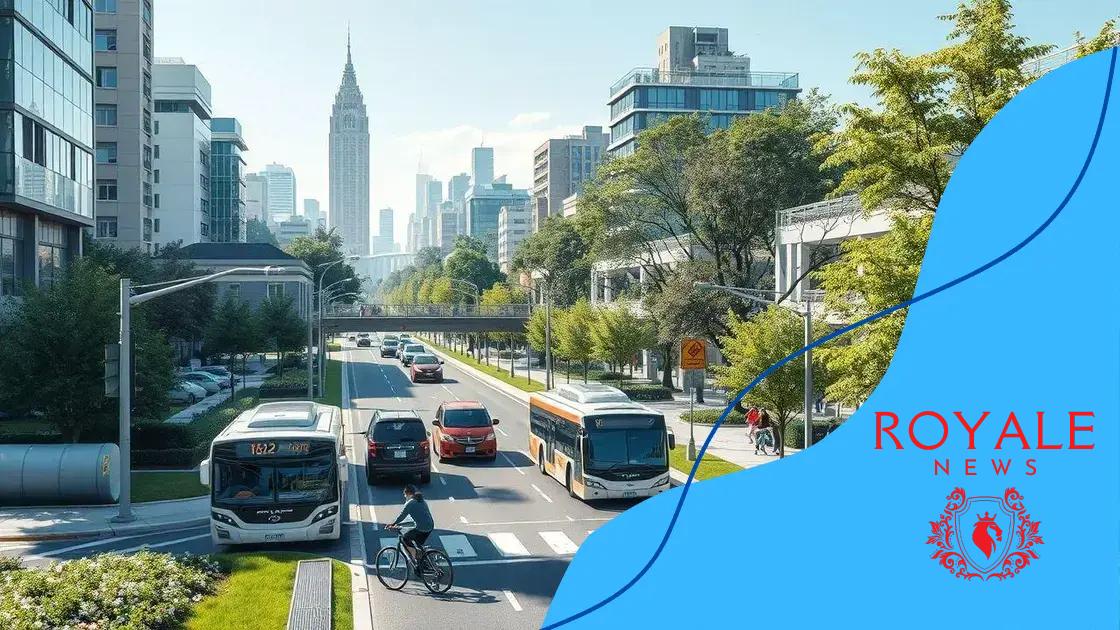Smart cities and the future of urban living

Smart cities improve urban living by utilizing advanced technologies, fostering community engagement, enhancing mobility and safety, and promoting sustainable practices, all while ensuring that residents have a voice in their development.
Smart cities and the future of urban living promise to enhance our everyday experiences in urban environments. Imagine a city where technology seamlessly integrates with daily life, making commuting easier and resources more efficiently managed. Isn’t that a future worth exploring?
What defines a smart city?
What defines a smart city? In today’s world, smart cities are emerging as a solution to urban challenges. These cities use technology to enhance the quality of life for their residents. But what exactly makes a city ‘smart’? Let’s explore this concept further.
Key Features of Smart Cities
At the core of a smart city are several essential features:
- Integrated Technologies: Smart cities leverage IoT (Internet of Things) to gather data and manage resources efficiently.
- Sustainable Practices: These cities focus on sustainability, utilizing renewable energy and promoting green spaces.
- Data-Driven Decision Making: By analyzing data, city planners can make informed choices that benefit residents.
Moreover, connectivity is vital for a smart city. High-speed internet access allows residents to stay connected and access services easily. In addition, smart transportation helps to reduce traffic congestion and pollution, leading to a cleaner environment.
Community Engagement
A smart city isn’t just about technology; it also involves the community. Engaging residents in decision-making processes ensures that their needs are met. This involvement can include feedback mechanisms through apps or community forums.
Smart cities also promote accessibility for all, ensuring that everyone can benefit from the advancements. This approach fosters an inclusive atmosphere, making urban living more enjoyable and equitable. When residents feel a part of the transformation, the city thrives.
Overall, smart cities represent a future where technology meets community needs. They aim to create a harmonious balance between innovation and quality of life, paving the way for more effective urban living.
Key technologies driving smart city initiatives
Key technologies driving smart city initiatives are essential for creating more connected and efficient urban environments. These technologies allow cities to operate intelligently, addressing everyday challenges faced by residents.
Internet of Things (IoT)
The Internet of Things (IoT) plays a critical role in smart city infrastructure. By integrating sensors into various city systems, IoT enables the collection of real-time data.
- Traffic Management: Sensors help monitor traffic flow, reducing congestion.
- Smart Lighting: Streetlights adjust their brightness based on pedestrian presence, saving energy.
- Environmental Monitoring: Sensors detect pollution levels, helping cities address air quality issues.
This network of connected devices creates a data-rich environment that supports better decision-making. Furthermore, big data analytics helps city planners interpret this data effectively.
Artificial Intelligence (AI)
Artificial Intelligence (AI) complements IoT by analyzing the vast amounts of data collected. AI algorithms can identify patterns and predict trends, improving city services.
For example, AI can optimize public transport routes or enhance emergency response times by predicting demand. This means quicker access to essential services for residents.
In addition, smart grids utilize AI to manage energy distribution efficiently, promoting sustainability. This results in more reliable energy sources and lower operational costs.
5G Technology
The emergence of 5G technology also significantly impacts smart cities. Its high-speed connectivity enables better communication between devices and systems.
With 5G, smart transportation systems can work seamlessly, providing real-time updates to commuters. This technology is crucial for autonomous vehicles and other advanced transportation solutions.
In summary, these key technologies are transforming urban living. They create more responsive, efficient, and sustainable environments that cater to the needs of all residents.
Benefits of smart cities for residents

Benefits of smart cities for residents are numerous and increasingly vital in today’s urban setting. These advanced cities leverage technology to improve overall quality of life, making daily experiences easier and more enjoyable.
Enhanced Mobility
One of the primary advantages is enhanced mobility. Smart cities use integrated transportation systems that provide real-time updates on public transit. This means that residents can easily find the quickest routes and avoid delays.
- Public Transport Efficiency: Timely information reduces wait times for buses and trains.
- Smart Traffic Management: Traffic signals can adapt to real-time conditions, easing congestion.
- Ride-Sharing Integration: Options for ride-sharing are readily available, offering residents flexible travel solutions.
With these improvements, urban commuting becomes less stressful, contributing to lower levels of frustration and increased productivity.
Improved Safety
Safety is another crucial benefit of smart cities. Surveillance systems and urban sensors monitor environments, enhancing security in neighborhoods.
For instance, smart streetlights equipped with cameras can deter crime by increasing visibility. Additionally, emergency services can respond faster to incidents, thanks to real-time data sharing. This proactive approach helps create safer communities for everyone.
Environmental Sustainability
The focus on sustainability in smart cities also greatly benefits residents. By promoting green energy and efficient waste management, these cities reduce their environmental impact.
- Clean Air Initiatives: Monitoring air quality allows for timely actions to combat pollution.
- Recycling Programs: Smart bins help manage waste more effectively, promoting community recycling.
- Green Spaces: Public parks and gardens enhance urban aesthetics and provide recreational areas.
Residents enjoy healthier living conditions and a more vibrant city landscape that fosters community interaction.
Furthermore, smart technology can provide valuable resources, such as energy savings and increased property values. All these factors contribute to making urban living more enjoyable and connected, resulting in a cohesive community feel.
Challenges in implementing smart city solutions
Challenges in implementing smart city solutions are significant hurdles that urban planners and governments face. While the benefits are apparent, the path to realizing smart city concepts is filled with obstacles.
High Costs
One major challenge is the high costs associated with smart city technologies. The initial investment for sensors, infrastructure, and systems can be overwhelming.
- Budget Constraints: Many cities operate on tight budgets, making it difficult to allocate funds for new technologies.
- Maintenance Expenses: Ongoing maintenance costs can strain city resources further.
- Funding Sources: Securing funding from investors or grants can be a complex process.
These financial burdens often lead to delays in project implementations, and cities may struggle to justify the upfront expenditures.
Data Privacy Concerns
Another significant challenge involves data privacy. As smart cities rely heavily on data collection, residents become concerned about how their information is used.
Ensuring that personal data is protected is crucial. Cities must implement strict regulations to safeguard residents’ privacy while still benefiting from data insights.
Building trust between citizens and authorities is vital for successful smart city initiatives. Transparency about data usage can help alleviate fears and encourage community participation.
Technological Integration
Successful smart city solutions require seamless integration between various technologies. However, many cities face compatibility issues.
- Legacy Systems: Outdated infrastructure can hinder the adoption of new technologies.
- Interoperability: Different technologies must work together, which can be challenging to achieve.
- Skills Gap: Cities may lack the technical expertise required to implement and manage these solutions.
Addressing these integration challenges is crucial for effective deployment and allows for smoother operations of smart city features.
These obstacles, while daunting, do not overshadow the potential for smart cities. Recognizing and addressing these challenges head-on is essential for paving the way for innovative solutions that improve urban living.
The role of community in shaping smart cities
The role of community in shaping smart cities is vital for the success of urban development initiatives. Engaging local residents empowers them to influence how their cities evolve.
Community Engagement
First, active community engagement leads to better decision-making. When residents participate, their voices can shape policies that reflect their needs and values.
- Feedback Mechanisms: Utilizing surveys and public forums allows citizens to share their opinions.
- Workshops and Events: Organizing community events fosters connection and encourages collaboration.
- Online Platforms: Social media and dedicated apps help gather input and ideas easily.
This kind of involvement ensures that smart city strategies are tailored to fit the unique characteristics of the community.
Building Trust
Building trust is essential for a thriving smart city. Residents need to feel that their concerns are heard. Officials must prioritize transparent communication to establish credibility.
By sharing information about upcoming projects and initiatives, city leaders can create a sense of partnership between the government and the community. This collaboration promotes a shared vision for the future, where everyone is invested in the outcome.
Local Innovation
Moreover, local innovation plays a crucial role. Communities can foster innovative solutions that address specific urban challenges. Encouraging local startups and entrepreneurs leads to new technologies and services.
- Incubators and Accelerators: Supporting local businesses can spur economic growth.
- Collaborative Projects: Community members can collaborate on technology trials and initiatives.
- Educational Programs: Workshops and courses can teach residents about smart technologies.
These innovations often rise from grassroots efforts, further enhancing the identity and sustainability of the community.
In summary, the community’s involvement in shaping smart cities is crucial. By fostering engagement, building trust, and encouraging local innovation, cities can create environments that truly reflect the needs and desires of their residents.
FAQ – Frequently Asked Questions about Smart Cities
What is the role of the community in a smart city?
The community plays a vital role by actively engaging in decision-making, sharing feedback, and contributing to local innovations.
How can residents engage in shaping their cities?
Residents can participate through surveys, community workshops, and online platforms to voice their opinions about urban development.
Why is trust important for smart city initiatives?
Building trust ensures that residents feel heard and valued, leading to better cooperation and more effective urban solutions.
What are some benefits of smart city technologies?
Smart city technologies enhance mobility, improve safety, increase sustainability, and foster local innovation, making urban living more enjoyable.





